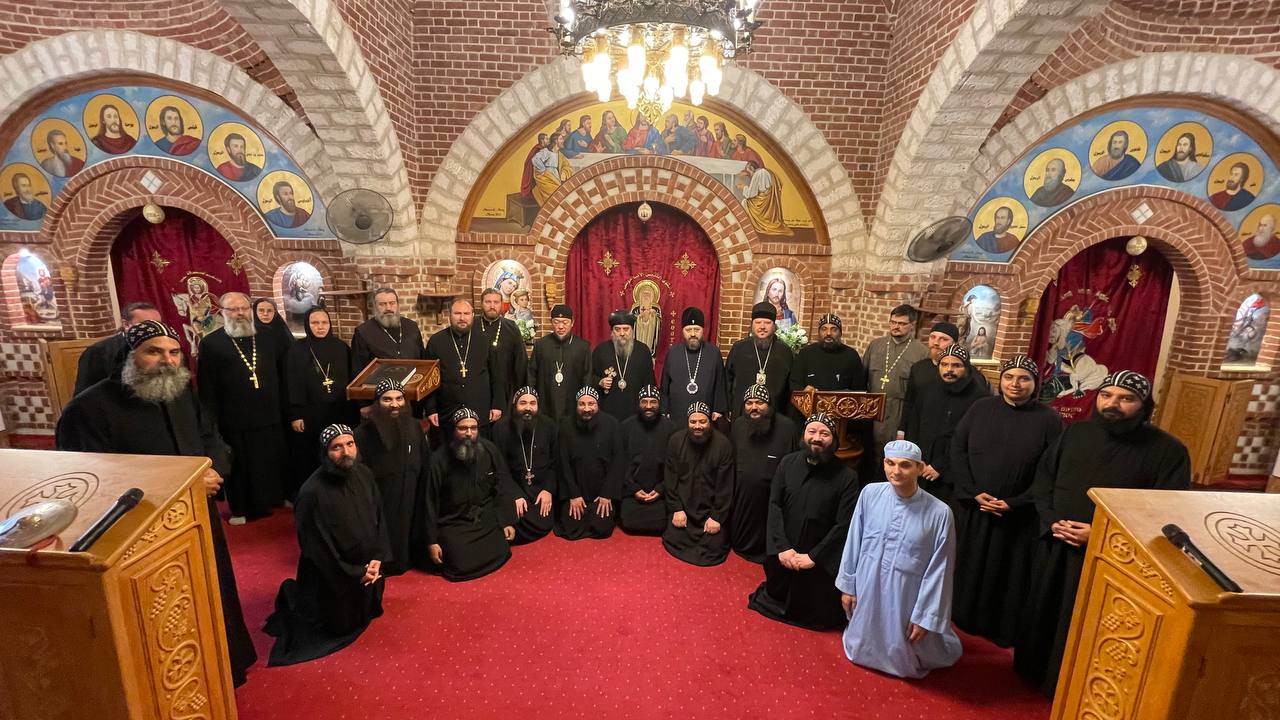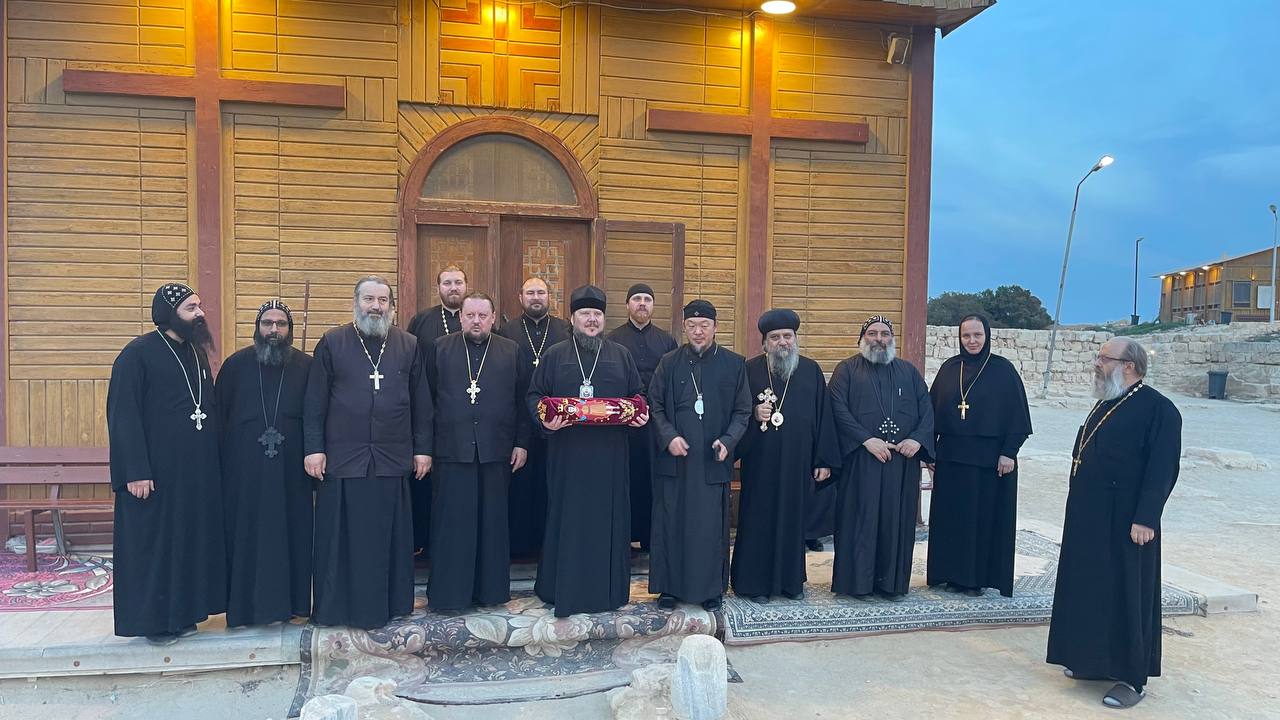
Russian Monastic Delegation Visited Centers of Christianity in Egypt

Pic: Gerges Mounir Hanna

mospat.ru
DECR and Gerges Mounir Hanna (OCP) – 17/11/2023
Cairo-Egypt: On November 7-15, with the blessing of His Holiness Patriarch Kirill of Moscow and All Rus’ and at the invitation of His Holiness Patriarch of the Coptic Tawadros II, a delegation of clergy and monastics of the Moscow Patriarchate visited Egypt for pilgrimage to places associated with the history of the emergence and flourishing of Christian monasticism, as well as getting acquainted with modern life men’s and women’s monasteries of the Coptic Church.
The trip took place in the context of the development of dialogue between the Moscow Patriarchate and the Coptic Church within the framework of the activities of the corresponding bilateral Commission.
The delegation was headed by Archbishop Jonathan of Abakan and Khakassia. It also included: Archbishop Feofan of Korea, temporary administrator of the Kyzyl diocese; Bishop Kallinik of Bakhchisarai, vicar of the Simferopol diocese; DECR Secretary for Inter-Christian Relations Hieromonk Stefan (Igumnov); Abbess Elizaveta (Pozdnyakova), abbess of the Martha and Mary Convent of Mercy in Moscow; the head of the diocesan icon painting workshop of the Abakan diocese, Abbess Ekaterina (Solovieva); clergy of the Abakan diocese – Archpriest Alexander Ilyin, Hieromonk Pallady (Vinnikov), Priest Pavel Kuzmin, Priest Yuri Zhatkin, Priest Roman Mogilat, Priest Artemy Mogilat, nun Maria (Artamkina), resident of the Prince Vladimir Monastery of the Kyzyl Diocese, monk Anatoly (Zavertkin); employee of the Bakhchisarai deanery of the Simferopol diocese A. Lepekhin.

On November 7, the delegation arrived in Cairo. At the airport, the guests were met by the vicar of His Holiness the Coptic Patriarch Tawadros II, the rector of the Monastery of St. Moses Murin in the Nitrian Desert, Bishop Saveriy, the representative of the Coptic Church in Russia, Hieromonk Daoud al-Antoni, clergy and monastics of the Coptic Church.
Upon arrival in Cairo, Russian pilgrims visited the historical Christian center of the city – the temple in the name of the martyrs Sergius and Bacchus, under which there is a grotto where the Holy Family once stayed; the temple of the holy martyr Barbara, where part of her relics resides, as well as parts of the relics of the martyrs Juliana, Damiana and other saints of the first centuries of the Christian era; Coptic convent of the Great Martyr George the Victorious (Mar Girgis); the famous Coptic “Hanging Church” (Muallyaka), built on the ruins of the ancient Roman fortress “Babylon of Egypt” and for a long time was the cathedral of the Coptic Patriarchs; The Coptic Museum and Temple of the Blessed Virgin Mary in Maadi, erected on the site where, according to legend, the Holy Family managed to break away from their pursuers in their wanderings across Egypt, crossing to the other side of the Nile.
On November 8, the delegation arrived in the Nitrian Desert (Wadi an-Natrun), located between Cairo and Alexandria, the birthplace of Christian monasticism.
The first stop of pilgrims in the Nitrian desert was the monastery of St. Macarius the Great – a monastery founded in 360 by this saint revered throughout the Christian world and is the place of the earthly exploits described in the Egyptian Patericon and the blessed death of one of the founders of monasticism. Archbishop Jonathan and members of the delegation venerated the venerable relics of St. Macarius and other great ascetics, martyrs and prophets located in the monastery’s churches. Members of the delegation communicated with the brethren of the monastery.
On November 9, the delegation visited the monastery of the Romans (al-Baramus), also founded by St. Macarius the Great. This monastery dates its history back to 335 and is considered the first monastery in the Christian world. It received its name in memory of those who labored here at the end of the 4th century under the leadership of St. Macarius, the sons of the Roman Emperor Valentinian – Maximina and Domitia. Representatives of the Russian Orthodox Church were warmly welcomed by the brethren of the monastery, led by one of its inhabitants, now serving as hierarch in Western Europe – Bishop Luke of Geneva and Northern France. Members of the delegation venerated the relics of Saints Paphnutius the Great, Moses Murinus, Isidore and other desert fathers who once labored at the monastery and the place of the exploits of the Venerable Arseny the Great, examined the 4th century refectory – one of the premises of the cathedral church of the monastery, where many generations of the first monks performed agapes after the Sunday Liturgy , before going into the desert for solitary prayers.
On the same day, the delegation visited the monastery of the Syrians (al-Suriani), founded at the end of the 4th century by the disciples of St. Paisius the Great on the site where his distant cell was located, and named in memory of the presence of monks from Syria here for several centuries. The name of St. Ephraim the Syrian, who once came here to meet with St. Paisius the Great, is closely connected with this ancient monastery. On the territory of the monastery today you can see a tree that has been bearing fruit for more than one and a half thousand years, growing from the staff of St. Ephraim stuck into the ground – living evidence of the meeting of two great ascetics. Also in the monastery the cell of St. Paisiya, in which he performed the many-day feat of incessant prayer.
There was a fraternal communication between the guests and the abbot of the monastery, Bishop Metaos, and the inhabitants of the monastery.
On November 10, a delegation of the Moscow Patriarchate visited the Lavra of the Nitrian Desert – the monastery of St. Paisius the Great (Anba Bishoi), founded by this saint around 357. The delegation venerated the relics of many saints of the ancient Church located in the monastery. Archbishop Jonathan and members of the delegation were given a tour of the Patriarchal and Synodal Center “Logos” located on the territory of the monastery – one of the administrative complexes of the Coptic Patriarchate, where many events of historical importance took place, including meetings of the Joint Commission on theological dialogue between the Orthodox Church and the Ancient Eastern Churches, and also regularly hold meetings of the Holy Synod of the Coptic Church. A meeting took place with the rector of the monastery of St. Paisius, Bishop Agapius, and the brethren.
In the evening of the same day, having left the Nitrian desert, the pilgrims arrived in the Marriott desert in the vicinity of Alexandria. Here the delegation visited a monastery named after the holy great martyr Mina of Cotuan, who suffered for Christ in the 3rd century and was glorified by many miracles. Today it is one of the largest monastic centers and a place of pilgrimage in the Christian East. The guests met with the rector of the monastery, Bishop Kyrillos, and her brethren, visited the grave of His Holiness Patriarch Kirill VI, revered as a saint by the Coptic Church, and became familiar with the economic activities of the monastery, which includes, in particular, the production of olive oil, cheese, and marble processing.
On November 11, the pilgrims returned to Cairo and visited the medieval convent of the Coptic Church in the name of the holy martyr Mercury Philopator (Abu Seifen), where they were warmly received by the abbess and sisters.

On November 12, Archbishop Jonathan, co-served by several members of the delegation in holy orders and the rector of the parishes of the Russian Orthodox Church in Egypt, Priest Alexy Mashkov, celebrated the Divine Liturgy in the Church of the Holy Martyr Mina – a parish of the Moscow Patriarchate in Cairo. Believers of the Cairo parish of the Russian Orthodox Church, including employees of the Embassy of the Russian Federation in Egypt, prayed during the service.
At the end of the service, Archbishop Jonathan and the accompanying delegation visited the Cathedral of St. Mark the Apostle, located on the territory of the Patriarchal residence, where they venerated the honorable relics of the main enlightener of the Egyptian land and the incorruptible remains of St. Athanasius of Alexandria resting in the temple crypt. The Russian delegation also visited the Cathedral of the Holy Apostles Peter and Paul, located on the territory of the Coptic Patriarchate, and examined the museum exhibition dedicated to the new martyrs of the Coptic Church.
On the same day, the delegation visited the Cairo convent of the Great Martyr Theodore Stratilates (Amir Tadros), where they were hospitably received by Abbess Edrosis and the sisters. The pilgrims venerated the spring of St. Onuphrius the Great located on the territory of the monastery, which, according to legend, was once revealed through the prayers of this saint, the myrrh-streaming icon of the Great Martyr Theodore Stratelates, and many other shrines carefully preserved here.
In the evening, the delegation arrived in the Eastern (Arabian) Desert near the Red Sea, where the laurels of St. Anthony the Great and St. Paul of Thebes are located.
On November 13, the delegation visited the monastery of St. Paul of Thebes. At the main gates of the monastery, the guests were warmly greeted by its rector, Metropolitan Daniel, Chairman of the Patriarchal Commission for Monasteries and Monasticism of the Coptic Church, who had previously visited Russia several times as the head of Coptic monastic delegations. Guests from Russia visited the temple of St. Paul, where they venerated the tomb of the ascetic, installed in the very place where once miraculously appearing from the desert, lions dug a grave for the deceased elder in the cave cell where this saint of God labored.

On November 14, at the end of their stay in the Eastern Desert, Russian pilgrims visited the Lavra of St. Anthony the Great, founded at the beginning of the 4th century near the mountain where the founder of monasticism labored for about seven decades.
Members of the delegation climbed the mountain, where they visited the cell of St. Anthony, which has survived to this day and performed a prayer service there.
At the foot of the mountain, the guests were met by the abbot of the monastery, Bishop Justus, and his brethren. Accompanied by the Bishop, and the abbot, the pilgrims took a tour of the vast territory of the Lavra, getting acquainted with its various economic activities, visiting the monastery churches, and venerating the shrines located in them. The delegation visited the spring of St. Anthony, which originates at an altitude of more than 400 meters and daily brings up to 100 cubic meters of water to the monastery.
On November 15, the delegation left for Cairo and, after a short stop in the Egyptian capital, flew to Moscow.
Source: DECR
